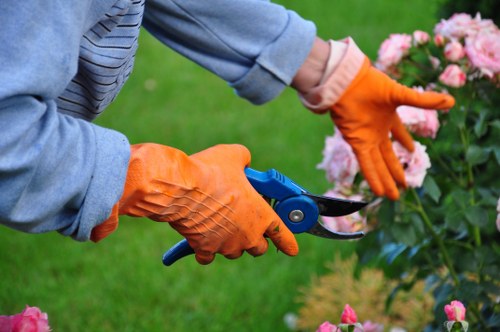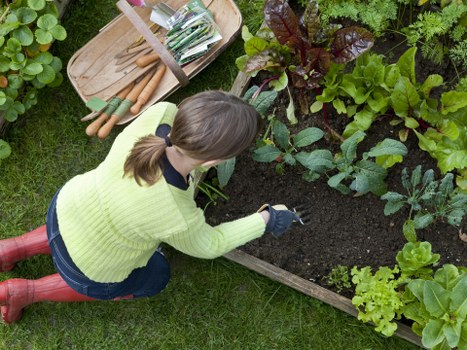Lawn Turf Installation in Garden Landscapes
Introduction to Lawn Turf Installation

Transforming your garden landscape with lawn turf installation can significantly enhance the aesthetic appeal and functionality of your outdoor space. Whether you're aiming for a lush green lawn, creating a play area for children, or needing a durable ground cover, installing turf is a practical solution.
Choosing the right turf type and understanding the installation process are crucial for achieving the desired results. This comprehensive guide will walk you through everything you need to know about turf installation in garden landscapes.
From selecting the perfect grass variety to proper maintenance techniques, we cover all aspects to ensure your lawn remains healthy and beautiful year-round.
Benefits of Lawn Turf in Garden Landscapes

Enhancing the beauty of your garden is just the beginning. Lawn turf offers numerous advantages that make it a popular choice among homeowners:
- Instant Greenery: Unlike seeds that take time to grow, turf provides an immediate lush green surface.
- Durability: Well-installed turf can withstand heavy foot traffic, making it ideal for active gardens.
- Low Maintenance: With proper care, turf requires less maintenance compared to other ground covers.
- Weed Control: A dense turf layer reduces the likelihood of weed growth, minimizing the need for herbicides.
- Improved Curb Appeal: A pristine lawn enhances the overall look of your property, increasing its market value.
Moreover, turf can contribute to environmental benefits such as reducing soil erosion and improving air quality.
Choosing the Right Type of Turf

Selecting the appropriate type of turf is essential for ensuring it thrives in your specific garden environment. Here are some popular turf varieties to consider:
- Fescue: Ideal for cooler climates, fescue is known for its fine texture and shade tolerance.
- Bermuda Grass: Suited for warmer regions, Bermuda grass is heat-resistant and highly durable.
- Zoysia: Combining the best traits of warm and cool-season grasses, Zoysia offers dense growth and low maintenance.
- Kentucky Bluegrass: Renowned for its rich color and lush appearance, it's perfect for areas requiring aesthetic appeal.
- St. Augustine: Thrives in humid climates and provides a thick, carpet-like lawn.
Factors to Consider When Selecting Turf

Before making a decision, evaluate the following factors to ensure the turf type you choose aligns with your garden's needs:
- Climate: Ensure the turf variety is suited to your local weather conditions.
- Soil Type: Different grasses thrive in varying soil compositions and pH levels.
- Sunlight Exposure: Some grasses require full sun, while others can tolerate shade.
- Usage: Consider the intended use of the lawn, such as for relaxation, sports, or ornamental purposes.
- Maintenance Requirements: Choose a turf that matches your willingness to perform regular upkeep.
Taking these factors into account will help you select a turf that not only looks great but also remains healthy and resilient.
Preparing Your Garden for Turf Installation

Proper preparation is the foundation of a successful lawn turf installation. Follow these steps to ensure your garden is ready:
- Clear the Area: Remove any existing vegetation, debris, rocks, and other obstacles from the installation site.
- Soil Testing: Assess the soil quality and pH levels. Amend the soil as necessary to create an optimal growing environment.
- Grade the Soil: Ensure the land is level and has proper drainage to prevent water pooling, which can damage the turf.
- Add Topsoil: Spread a layer of quality topsoil to provide a fertile base for the turf roots.
- Tamp the Soil: Firmly compact the soil to create a stable surface for laying the turf.
Taking these preparatory steps will help your turf establish quickly and reduce the risk of future problems.
Step-by-Step Turf Installation Process

1. Planning and Measurement
Accurate planning ensures you purchase the right amount of turf. Measure your garden area correctly, accounting for any irregular shapes or features.
2. Ordering Turf
Based on your measurements and the type of turf chosen, order slightly extra to account for cutting and fitting.
3. Laying the Turf
Begin laying the turf along a straight edge, ensuring each piece is tightly fitted against the next to avoid gaps. Stagger the seams for a natural appearance.
4. Rolling the Lawn
After laying, use a lawn roller to press the turf firmly into the soil, eliminating air pockets and ensuring good contact between roots and soil.
5. Watering
Immediately water the newly installed turf thoroughly. Keep the soil consistently moist for the first few weeks to promote root establishment.
Maintaining Your Newly Installed Lawn

Proper maintenance is key to the longevity and beauty of your lawn. Follow these essential tips:
- Regular Watering: Ensure your turf receives adequate water, especially during dry periods.
- Mowing: Keep the grass at an optimal height to encourage healthy growth and prevent weed infestation.
- Fertilizing: Apply appropriate fertilizers to provide necessary nutrients for the grass.
- Aeration: Periodically aerate the soil to improve air flow and nutrient uptake.
- Pest and Weed Control: Monitor for pests and weeds, addressing issues promptly to maintain lawn health.
Consistent maintenance practices will help your lawn remain vibrant and resilient throughout the year.
Common Mistakes to Avoid During Turf Installation

Avoiding common errors can save you time, effort, and money. Here are some pitfalls to watch out for:
- Poor Soil Preparation: Skipping soil preparation can lead to poor turf growth and increased susceptibility to diseases.
- Incorrect Turf Selection: Choosing a turf type unsuitable for your climate or soil can result in a failed installation.
- Improper Laying Technique: Overlapping or leaving gaps between turf pieces can create uneven surfaces and enable weed growth.
- Neglecting Watering: Insufficient watering post-installation can prevent the turf from establishing properly.
- Ignoring Maintenance: Failing to maintain the turf after installation can lead to deterioration and reduced lifespan.
By being mindful of these common mistakes, you can ensure a successful and lasting lawn turf installation.
DIY vs. Professional Turf Installation

Deciding between a DIY approach and hiring professionals depends on various factors:
Advantages of DIY Turf Installation
- Cost Savings: Eliminating labor costs can make turf installation more affordable.
- Control: You have complete oversight of the entire process.
- Satisfaction: Achieving the installation yourself can be highly rewarding.
Benefits of Hiring Professionals
- Expertise: Professionals bring experience and knowledge, ensuring the job is done correctly.
- Time Efficiency: Experts can complete the installation more quickly and efficiently.
- Quality Assurance: Professional installations often come with guarantees, providing peace of mind.
Consider your budget, skill level, and the size of your project when deciding between DIY and professional turf installation.
Cost Factors in Turf Installation

The overall cost of lawn turf installation can vary based on several factors:
- Turf Type: Premium turf varieties typically cost more but offer superior quality and durability.
- Area Size: Larger areas require more turf and materials, increasing the total cost.
- Soil Preparation: Extensive soil work and amendments can add to the expense.
- Labor Costs: Hiring professionals will include labor fees, which vary based on location and service provider.
- Additional Materials: Items like fertilizers, topsoil, and tools may affect the overall price.
Obtaining multiple quotes and comparing services can help you find the best value for your turf installation project.
Environmental Considerations

Installing lawn turf can have positive and negative environmental impacts. Here’s how to ensure your turf installation is eco-friendly:
- Sustainable Turf Choices: Opt for grass varieties that require less water and fertilizers.
- Organic Fertilizers: Use natural fertilizers to minimize chemical runoff and soil degradation.
- Water Conservation: Implement efficient irrigation systems, such as drip irrigation, to reduce water usage.
- Integrate Native Plants: Incorporating native plants alongside turf can enhance biodiversity and support local ecosystems.
- Reduce Lawn Area: Balancing turf installation with other landscape elements can create a more sustainable garden.
By considering these environmental factors, you can create a beautiful lawn that also contributes positively to the ecosystem.
Innovative Turf Installation Techniques

Advancements in turf installation have introduced innovative methods that enhance efficiency and quality:
Hydroseeding
This technique involves spraying a mixture of seeds, fertilizers, and mulch onto the prepared soil, promoting rapid and uniform grass growth.
Grid Systems
Using grid mats to lay turf ensures precise placement and easy alignment, reducing wastage and installation time.
Smart Irrigation Systems
Integrating smart irrigation systems with sensors allows for automated watering based on soil moisture levels, optimizing water usage.
Permeable Turf Solutions
Permeable turf systems enhance drainage and reduce runoff, making them ideal for areas prone to heavy rainfall.
Incorporating these modern techniques can improve the overall effectiveness and sustainability of your turf installation.
Seasonal Considerations for Turf Installation

Timing your lawn turf installation according to seasonal conditions can significantly impact the success of your project:
Spring Installation
Ideal for cool-season grasses, spring offers moderate temperatures and ample rainfall, promoting healthy growth.
Summer Installation
Better suited for warm-season grasses, summer installation requires careful watering due to high temperatures and potential drought.
Autumn Installation
Autumn provides optimal conditions for both cool and warm-season grasses, with balanced temperatures and reduced pest activity.
Winter Installation
Generally not recommended due to cold temperatures and potential frost, which can hinder turf establishment.
Choosing the right season ensures your turf has the best chance to thrive and establish strong roots.
Conclusion: Achieving the Perfect Garden Lawn

Installing lawn turf in your garden landscape is a rewarding endeavor that enhances both beauty and functionality. By carefully selecting the right turf type, preparing your garden adequately, following proper installation techniques, and maintaining your lawn diligently, you can enjoy a stunning green space for years to come.
Whether you choose to undertake the project yourself or hire professionals, the key to success lies in attention to detail and commitment to ongoing care.
Ready to transform your garden with lush, vibrant turf? Contact us today to schedule your turf installation service and take the first step towards a beautiful outdoor oasis.
Additional Tips for a Thriving Lawn

To ensure your lawn remains healthy and attractive, consider these extra tips:
- Regular Monitoring: Keep an eye out for signs of stress, disease, or pest infestation, addressing issues promptly.
- Proper Mowing Practices: Avoid cutting more than one-third of the grass height at a time to prevent weakening the turf.
- Thatch Management: Remove excessive thatch buildup to allow air, water, and nutrients to reach the roots.
- Soil Health: Periodically test and amend your soil to maintain optimal fertility and pH levels.
- Edge Maintenance: Keep lawn edges neat and defined for a polished and professional appearance.
Implementing these practices will help maintain a resilient and vibrant lawn that you can be proud of.
Frequently Asked Questions

1. How long does it take for turf to establish?
Typically, turf begins to establish within two weeks, with full maturity reached in about three to four months, depending on grass type and care.
2. Can I install turf on a sloped garden?
Yes, but it requires careful preparation to ensure proper drainage and prevent erosion. Techniques like terracing and using retaining walls may be necessary.
3. How often should I water my newly installed turf?
Watering should be done daily for the first two weeks. Afterward, gradually reduce the frequency while increasing the amount of water per session to encourage deep root growth.
4. Is turf installation environmentally friendly?
When done sustainably, turf installation can be environmentally friendly. Choosing native grass species, using organic fertilizers, and implementing water-efficient irrigation contribute positively.
5. How do I prevent weeds from growing in my new lawn?
Proper installation techniques, such as tightly fitting turf pieces and maintaining a dense lawn, help prevent weed growth. Additionally, regular maintenance and the use of pre-emergent herbicides can be effective.
For more detailed answers to your questions, feel free to reach out to our experts who are ready to assist you with your lawn turf installation needs.
Final Thoughts

Achieving a perfect lawn through turf installation is a blend of art and science. It requires careful planning, precise execution, and ongoing care. By following the guidelines outlined in this article, you can create a beautiful and enduring garden landscape that serves as a personal sanctuary and enhances the overall value of your property.
Remember, the key to success lies in choosing the right materials, adhering to best practices during installation, and committing to regular maintenance. With dedication and proper care, your lawn will remain a vibrant and inviting feature of your garden for many years to come.
Don't wait any longer to enjoy the lawn of your dreams. Book your service now and take the first step towards a stunning garden transformation.